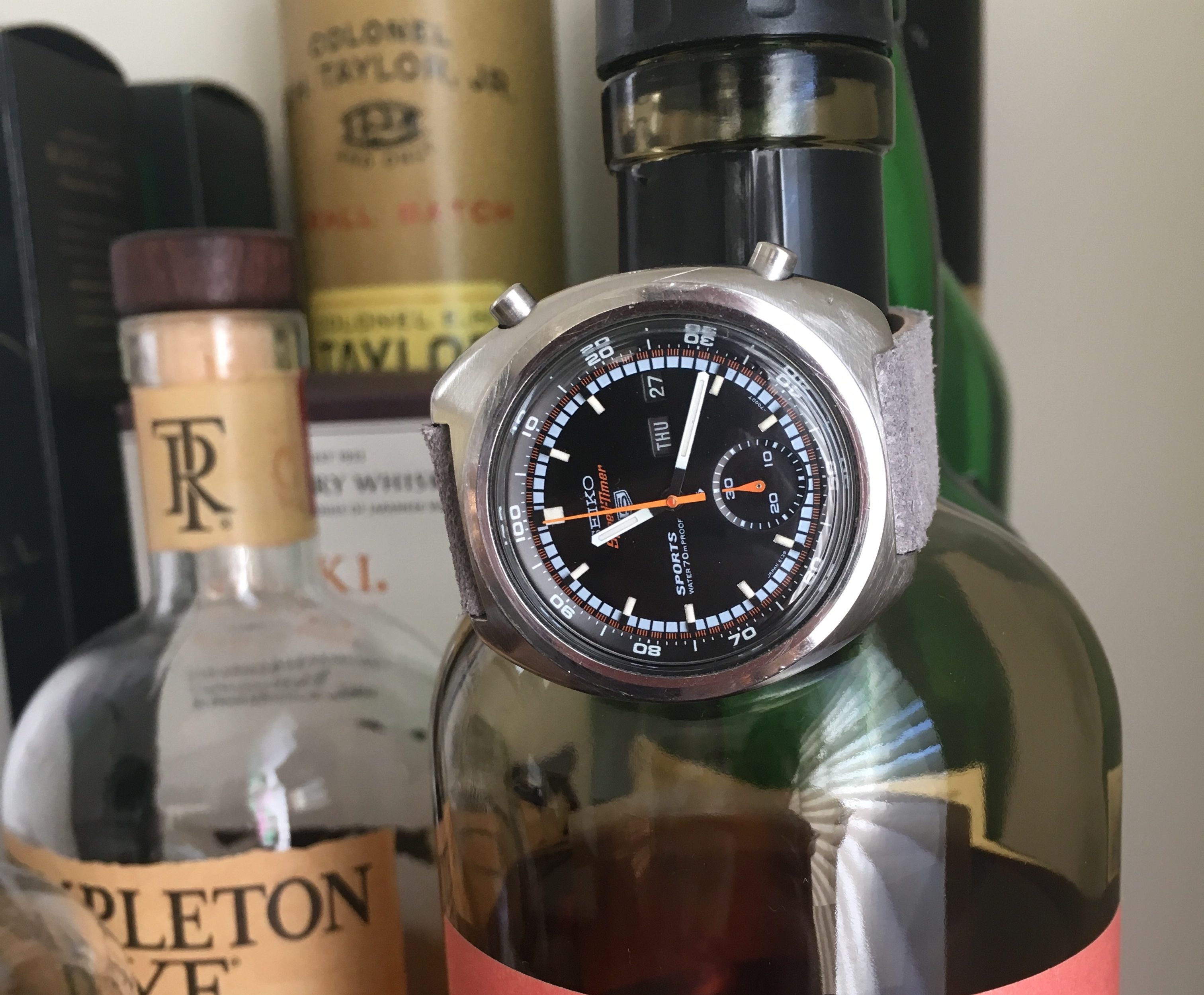I want to love the Pogue. Lord, how I want to love the Pogue. It’s been to space, man, just like the beloved Speedmaster but (unlike the Omega) can be had for a more than reasonable price for a vintage piece with such provenance. And you know what? Not only was this thing in space, but the astronaut who took it up (and for whom it was nicknamed) was issued a Speedy. Yet he smuggled this watch, his PX-purchased Seiko*, aboard Skylab 4. Think about that. NASA issues you an Omega Speedmaster, the watch that had landed on the moon, but it’s your trusty Seiko that is worth the trouble of sneaking contraband on the mission. Lord, how I want to love the Pogue.
But it’s yellow.
That’s the thought that haunts me every time I come close to bidding on one. Some say that the true Pogue has a richer, more nuanced gold color to it but, come on – it’s yellow. The Pogue has been to space. But it’s yellow. You can have a watch worn by a NASA astronaut on a significant NASA mission second only to the one worn on the moon! But it’s friggin’ yellow!
It’s not an ugly watch. In fact, it’s a handsome watch in many ways. It looks fabulous with NASA white. It fits Colonel Pogue splendidly. But when am I going to wear a yellow watch (with a Pepsi bezel at that)? It’s certainly a matter of opinion and I am particular with my tastes. I do prefer vintage watches over modern. My collection is mostly focused on tool watches (field watches, divers, chronographs), though a few other pieces have made it into the watch box. I’ve even flirted with orange dialed watches (though I haven’t had the wherewithal to take the plunge) like the quite lovely Doxa Black Lung. But the Black Lung’s bezel and chapter ring are understated and elegant for a tool watch. Don’t get me wrong. I love me a Pepsi bezel and have an SKX with one. But a yellow/gold dial with a blue and red bezel? That’s a lot of color, man.
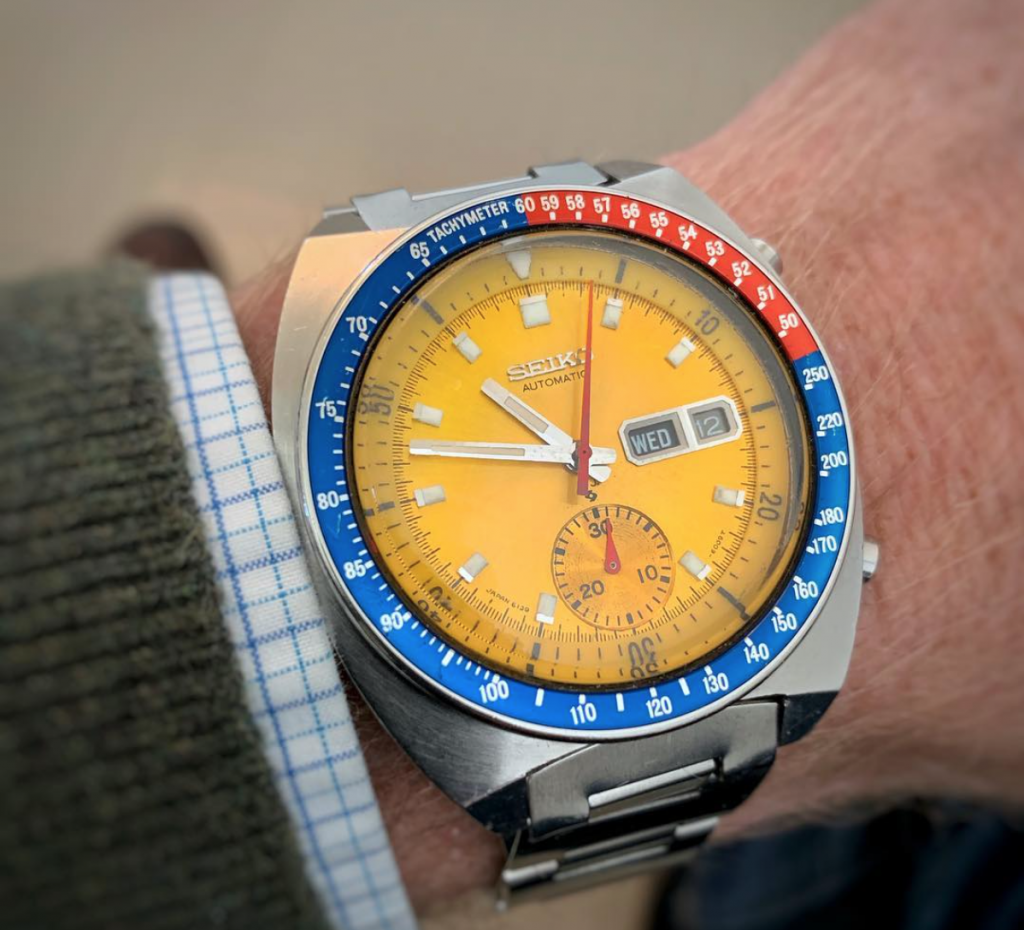
Photo Credit for the Pogue: @skew069
(As I’m writing this, I’m looking at a few Pogues on eBay. My brain is telling me that this is a solid piece and would be an asset to my collection, but my gut is asking, are you going to wear it or stare at it?)
I was conflicted about this watch for a long time. I’m a purist when it comes to watch collecting. It’s always been important to me to get the real deal, the exact thing I’m in the market for. In this case, it’s what people call the “True” Pogue (not only the yellow one, but one with a very particular dial variant). Many people refer to all different variants (yellow/gold, blue, black, silver) of the 6139 chronograph as Pogues, but it’s only the yellow/gold 6139-6002 that can accurately (if you’re being a purist) be called a Pogue. Yellow. What a bummer.
Still, there’s so much appeal in the design grammar of the 6139, inside and out, that I had to find my own way into enjoying this model while still feeling like I’m not just getting another (less noteworthy) version of the famed Pogue.
Thank the lucky stars we’re talking about Seiko.
Can I just say a few words about Seiko that have been stated ad nauseum? I’m a relatively new collector (I’ve been serious for about 4-5 years) and, if you’re a snob, then my enthusiasm for the already-lauded brand will likely make you roll your eyes and ask why you’re reading another trite blurb of Seiko sycophancy. However, if you’re a real collector, then you’re probably a Seiko fan and, if you’re a Seiko fan, then you never tire of hearing their praises sung from the highest peaks to the deepest depths. Well, maybe that’s overkill.
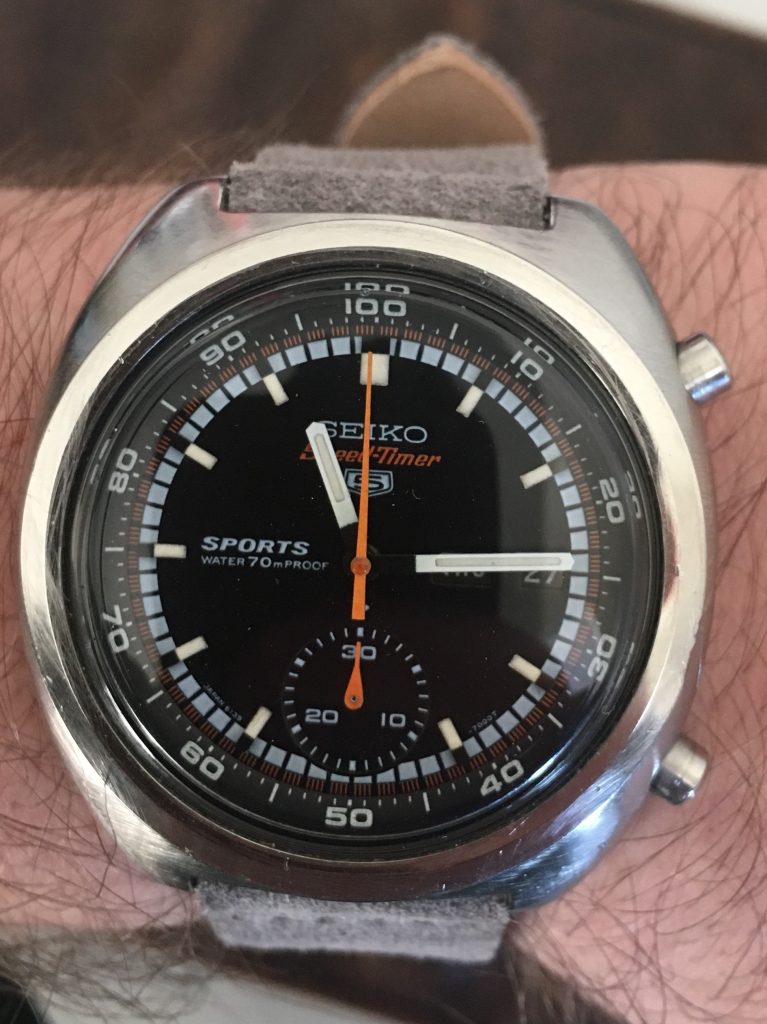
At the risk of further exposing my newbie-esque excitement, can I say a few words about vintage Seiko? Vintage Seiko is where it’s at. Whether you’re a seasoned collector with a big budget or a new enthusiast with a little fun money squirreled away, there are innumerable options for affordable vintage pieces that are a great value but not cheap. For someone driven largely by aesthetics, the designs are eye-catching, well-balanced, and artful. If you’re more about what’s under the hood, the movements in these watches go from dependable workhorses to innovative icons. Some, as in the case of the 6139 (arguably the first automatic chronograph movement), have become icons because of their dependability.
What’s great about any 6139 is that, even if it doesn’t have the provenance of being a moon watch, it still contains a movement that played a pivotal role in the history of horology. This was the deciding factor in my making peace with not pursuing the Pogue. I knew I was still going to get something great in the 6139 family.
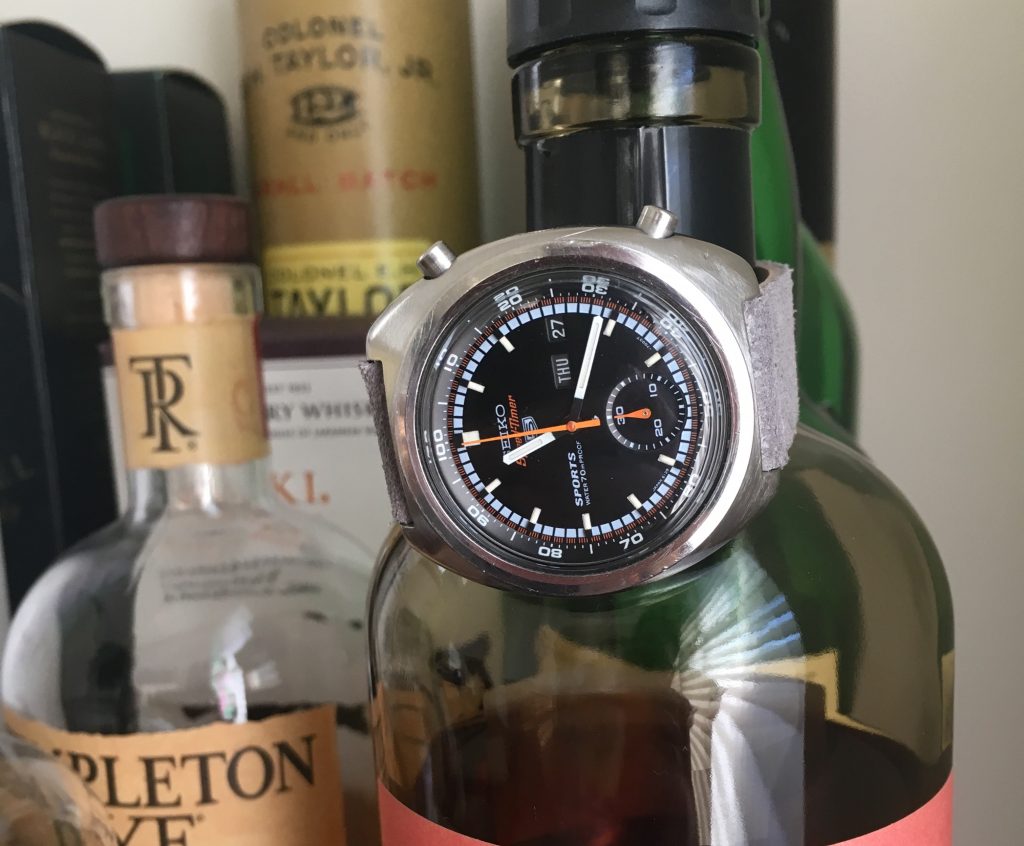
My watch is a 6139-7000 from 1970. From what I can see and what I’ve been told from a particular Seiko expert (for the purposes of this article, we’ll call him Blencer Blein) it’s in excellent condition and is pretty rare. In particular, what makes it rare are a few minute details: the bracelet (one of a number of funky 70’s designs that you often find with these Seiko racing chronographs) and the fact that the center pinion of the chronograph hand is in an orange lacquer (as opposed to being painted black). In fact, much of my experience with finding this watch (and with vintage Seiko hunting in general) has to do with these small variations. As has been said, there are so many frankenwatches out there in the world of Seiko that one really needs to do their homework before plunking down cash for one.
I acquired this watch through a less-than-ideal eBay transaction. Searching for 6139’s I came across this one (in pristine condition and with original bracelet!). I waffled over bidding on it, the sleeve of my mind still being tugged in the Pogue direction, but decided that I’d be crazy not to go for it. After a small bidding skirmish, I won the watch and was thrilled. Then the horror show began.
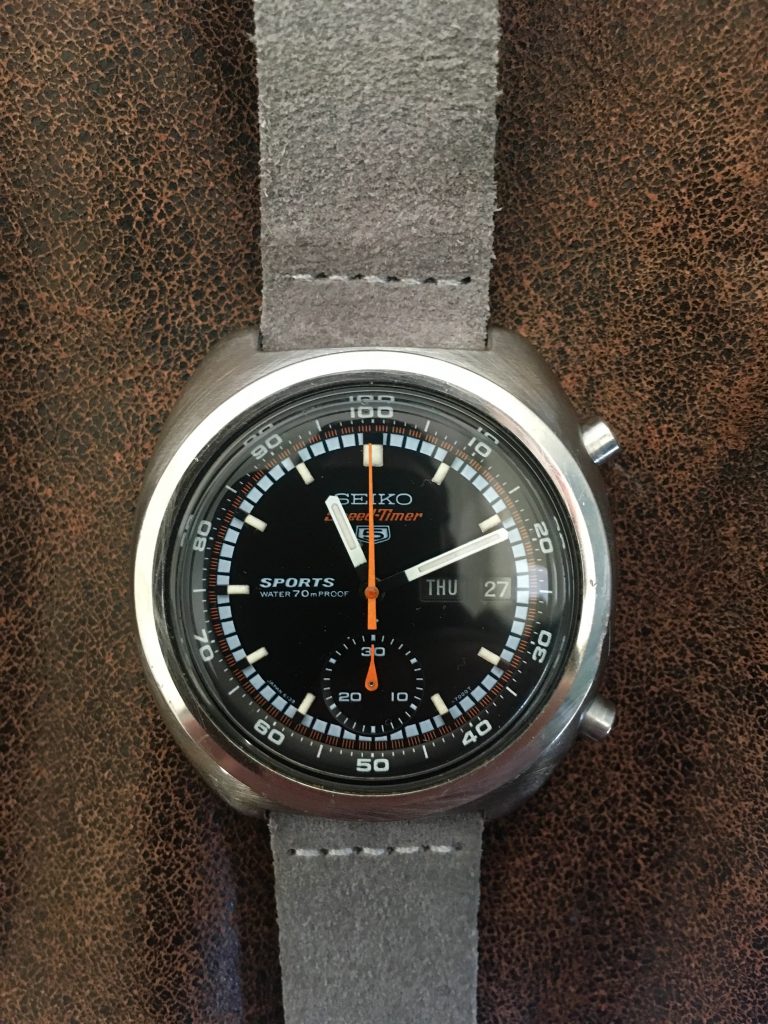
I’m sure it’s true with a lot of watches, but especially with Seiko (and vintage Seiko at that), that saavy buyers know to avoid overseas dealers from certain places (Singapore being the chief source of franken-creations) like the plague. So, naturally, I tried to limit my saved listings to US sellers only no matter how tempting the low price offered by an overseas seller might have been. Sometimes those fake watches’ fake details are glaring and embarrassing to everyone involved. Other times, it’s hard to tell, adding to the temptation. Regardless, my gut told me to stay away.
Well, you know that sinking feeling you get right after you think you’ve made a good decision only to find out you were dead wrong? In this case, that feeling set in when, after paying for the watch, I was given an invoice showing that it would be shipped not from Baltimore, but from Jeddah, Saudi Arabia. Not that watches coming out of Saudia Arabia are fake or franken-ed. Hell, they might be. I don’t know enough about the grey watch market in Saudia Arabia to be snooty about it. But the flagrant misrepresentation on the part of the seller made my knees buckle. I mean, what would YOU think about the source of said watch if the seller had to lie about it in order to make a sale?
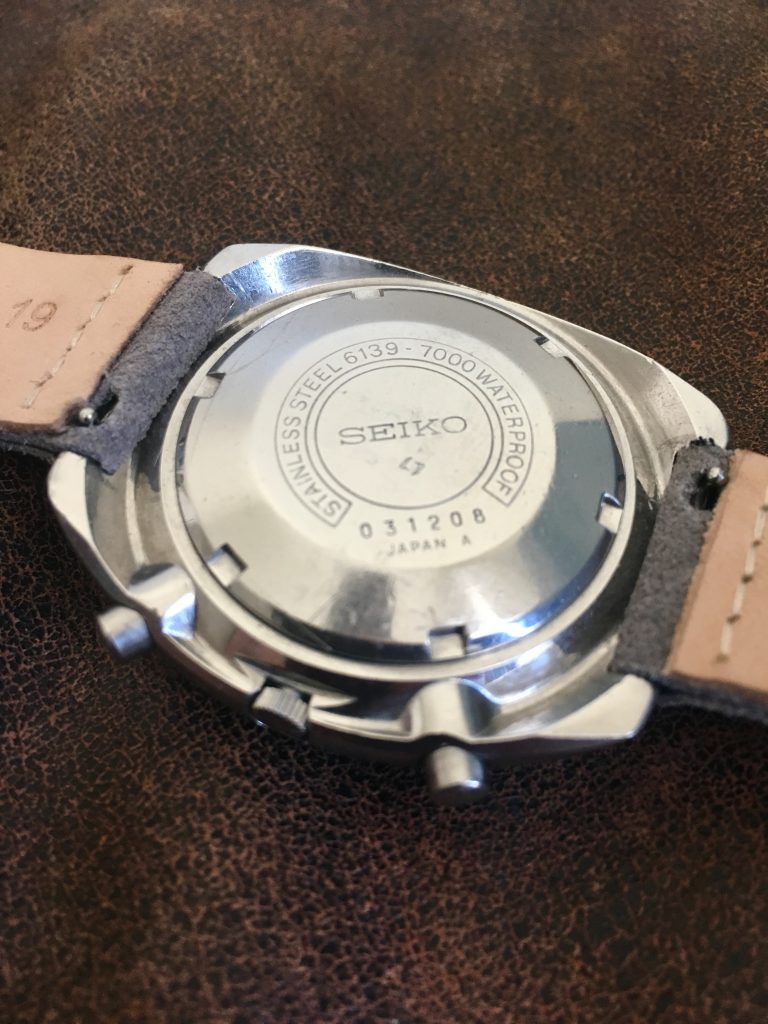
Luckily (I mean, luckily), after some complaining to eBay and back and forth with the seller, the watch arrived (several weeks later, during which I had been holding my breath until I turned blue). Upon first inspection it looked solid: no polishing on the case, no blemishes on the dial, normal wear on the caseback. The watch ran, the date set, the chronograph worked and snapped back to zero (Mostly. Sometimes after a couple of tries). The original bracelet was there and was in great condition, also. I’m not the type who gets lucky in situations like this. In fact, quite the opposite. Oh, I’ve been burned before. So when the watch arrived in fantastic condition (cosmetically and functionally), I wore the shit out of it.
It’s a very wearable piece. 40mm cushion case. The indices have patinated to a nice, even cream color. The markers and chronograph hands are a sharp orange that pops off the black dial. It has all the dial markings a vintage Seiko nut could want: “Speedtimer,” “Sports,” “70m Water Resist.” Even a Suwa symbol. There’s a quick set date function (where you press in the concave crown to change the day and date) and the chronograph has been useful in all sorts of (non-racing/non-adventure) situations. The bracelet is super comfortable, albeit a bit jangly (as a lot of 60’s and 70’s bracelets are) and watch looks great on leather rally straps, vintage straps, and nato straps. It has 19mm lugs (a little annoying but it works with a thick leather 18mm strap).
View this post on Instagram
Speaking of 19mm lugs, if your watch has 19mm lugs, and I can’t stress this enough, please, for the love of all that is holy in the gears, springs, and jewels of your watch’s movement, please, make sure it has 19mm spring bars. I found this out the hard way when, while wearing the shit out of the watch on a nato, one of my 18mm spring bars slid out. The strap made a valiant effort to keep the watch on my wrist but, lo and behold, the watch fell to the ground and I watched as, in slow motion (it seemed), my beloved 6139-7000 slammed onto the tile floor of my kitchen chrono-pushers first.
After all the sweating and breath-holding of my eBay transaction, I managed to break the damn thing only a few weeks after having it. Luckily, I found a reliable watch repairer nearby who had a lot of experience with vintage watches, vintage Seikos in particular.
Whew. That was a close one. Breathe.

Henry is a scholarly watch nerd based out of northern New Jersey. He works as a professor of composition and creative writing by day and a fiction writer by night. Both his academic and creative work have given him insight on design and rhetoric and his fiction writing background influences his humorous, narrative take on watch reviews. His watch collecting habits tend to lean toward vintage, but he never shies away from unique and interesting new pieces. Henry is also an avid musician, record collector, whiskey aficionado, serial hobbyist, and all-around enthusiast.
